A Long Road to Salerno
Mark and I’s latest Saturday game was the full campaign of Salerno ’43. Since my earlier play of the short game, I’d been wondering what the full campaign would play like, and so when we got back to the ZOC-bond games, that was my choice. I had the Allies again, while Mark took the defending Germans for his first play.
The initial landings went well, with only Sugar Beach failing to advance two hexes, and the Commandos took Salerno and Nocera Inferiore. (…That would seem to be illegal, since that would have been an advance after a Breakthrough Combat in Salerno. It was a DS, but the allowed advance would be counted from the “landing” combat, not the second one; which as the first combat of the game, was missed. And they’re foot units, and can only advance 2 anyway. But this turned out poorly for me anyway.) Mark set up a loose cordon around the landings and counterattacked Nocera, disrupting the Commandos.
The second wave landed, and I attacked south, eliminating a panzer battalion, while pulling out of Nocera. Despite taking to the hills, and help from Fleet Air Arm, the Germans got a A1/D1 to knock out the Commandos guarding the way south on turn 2, and advanced to outside of Salerno. The Americans pushed south, while the 45th division started landing to cover the beaches, while the British pushed into the foothills and sent a brigade to garrison Salerno.
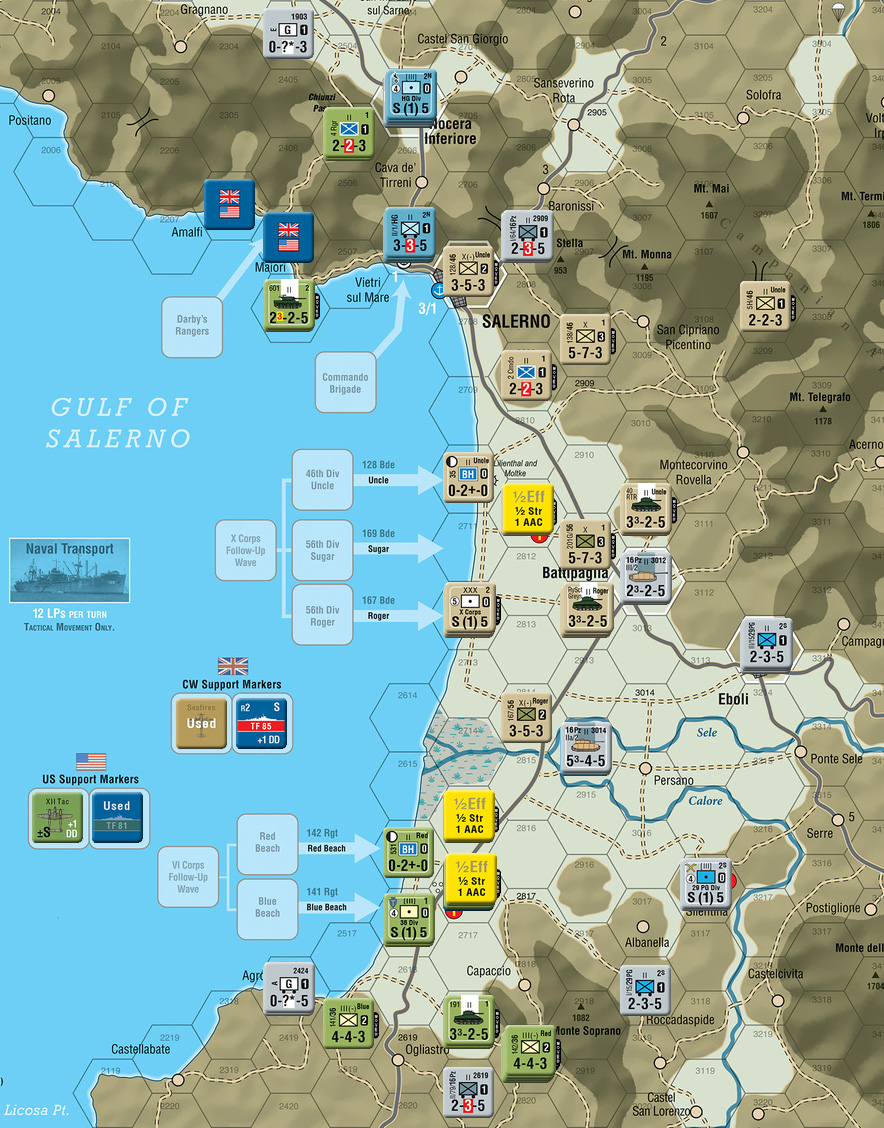
Near the end of Sept 10/turn 2.
Sept 11 dawned cloudy (which is to say, the weather roll skipped straight over the “C” box, and German air power), as the Germans rolled up to Salerno and managed a strong attack, and even with help from the Fleet Air Arm again, another A1/D1 pushed me out of Salerno (determined defense was possible, and maybe wise, but I didn’t feel like risking the remaining step). The British concentrated on consolidating their beachhead, pushing towards the mountains, and surrounding Battipaglia, while the Americans pushed south of the Alento.
German progress continued in the north, with an attack along the coast near Maiori, knocking out a battalion of tank destroyers, while a determined defense lost me a Ranger battalion. This opened the road to the American-held ports there, but thankfully, the determined defense was a ‘hold’ and the limited advance allowed kept the Germans short of Maiori. Down at the main landing area, a German attack broke through the British defense, and got a 7:1 second combat on my artillery park, which came up with a DR4, the only result that would not have cost me at least one of the X Corps or 56th Divisional artillery, even though being in full retreat put them out of action for two turns. The Americans moved to help cover north of the Sele, while pressing towards the south end of the Calore, and the remaining Rangers moved to hold Maiori. The British took Battipaglia, while the Americans drove off the units that had threatened the artillery with losses (A1/D1)
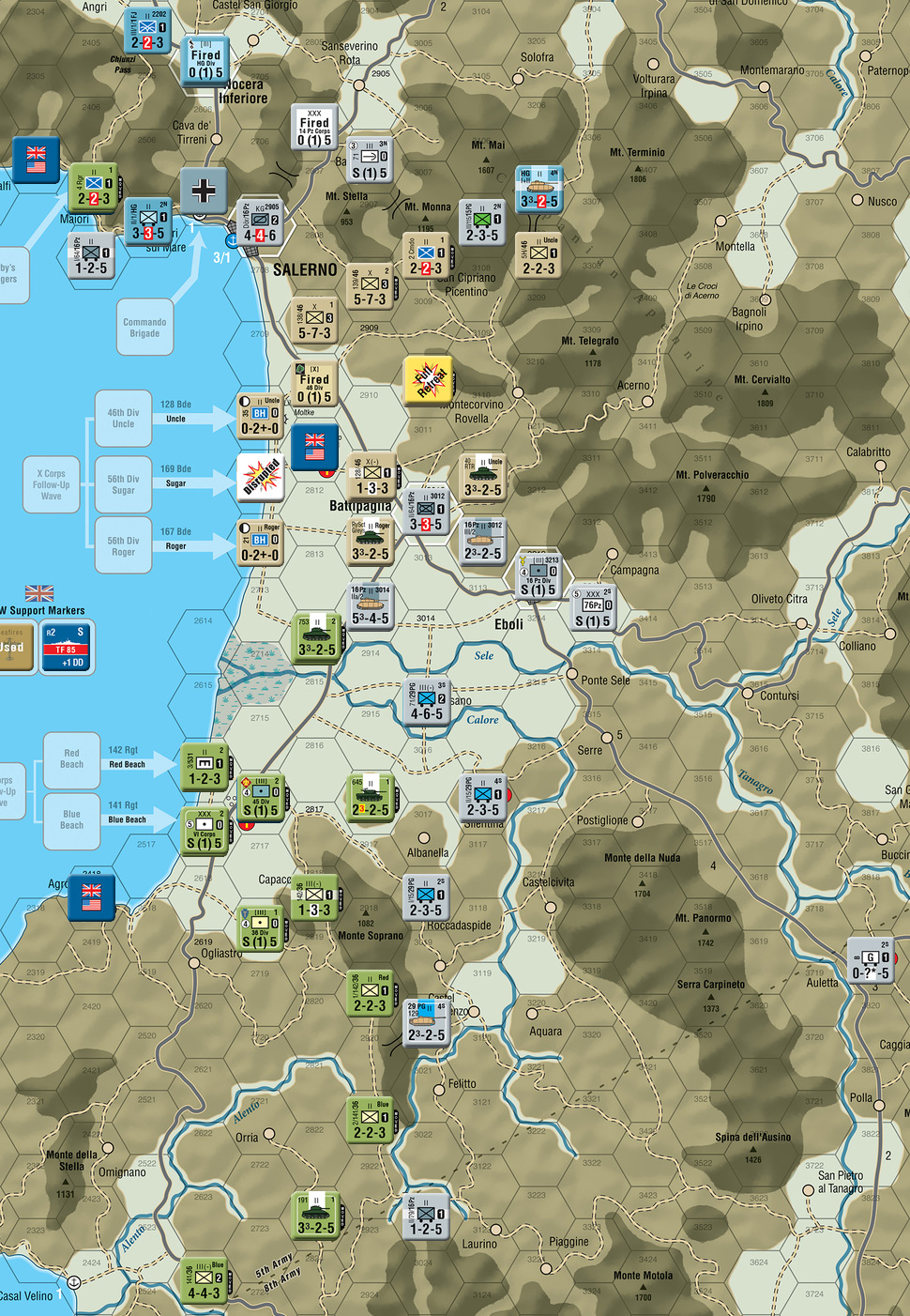
Before Allied attacks on Sept 12/turn 4.
Mark reworked his deployments after that, sending extra units to the north while the next wave of reinforcements from the south raced up to hold the center and south. The two Fallschrimjaeger battalions went to the west to threaten my flank; something that tied up too many troops for too long, but eventually spelled their doom. It was raining for turn 5/Sept 13, but the Americans attacked at Roccadaspide (with help from the first wave of the 82nd Airborne), and forced the Germans across the Calore.
The weather moved straight from rain to clear “B” promising a short dry spell, and Mark pressed on the British north flank, disrupting the British brigade holding the hills overlooking the coast, and in the center got a D1 in front of Eboli to threaten the British beaches again. I dropped the battalion of the 509th behind the lines near Oliveto Citra, hoping to get at the German artillery nearby, and hopefully get through in the center before their situation could get too desperate. Sadly, the attack merely disrupted the artillery. The second wave of the 82nd Airborne helped reduce a recon unit at Altavilla Silentina, and send it across the Calore, while other units crossed the river further south.
The weather got rough quick, getting cloudy (and skipping the German air support turn again), and Mark pulled back to the mountain passes in the south. I think he could have forced me to do a slow advance in there, buying two more turns, but the chances of getting outflanked were there. He then pushed in the land between the rivers, getting a D1 to force the Americans out of the area, and got in behind my leading units advancing on hills in the center. The problem with that was the two motorized regiments were unsupported, and I was able to surround them in turn. I only got an EX (leaving three steps trapped), but the defense of Eboli was weak, and the British cleared the city with a DS.
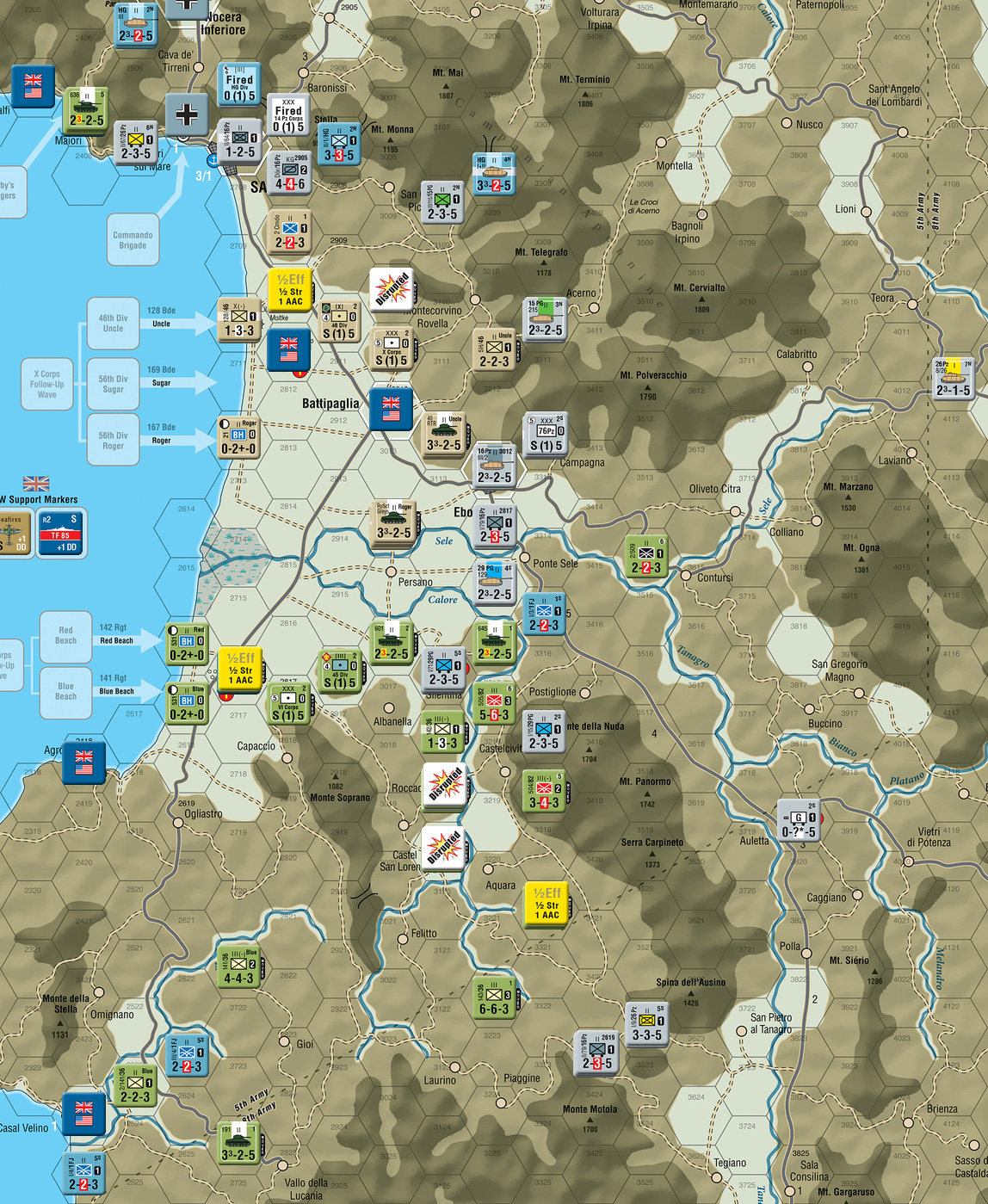
Just before Allied combat, Sept 15/turn 7.
The weather continued cloudy, and Mark moved north of my pocket and negate hexside-ZOC bond to spring his trapped units, while pulling artillery away from Eboli. With help from the British 56th Division, I cut that stack off and a DS knocked out four units. Meanwhile, the British knocked out the 29th PG’s Recon battalion as they they covered the retreat of artillery units from Eboli (the pair of combats pretty much eliminated the 29th Panzer Grenadier Division). Turning north, the 7th Armored was arriving, and helped push the Germans back towards Salerno. In the south, I was finally confronting the troops garrisoning the passes between the Spina dell’Ausino and Monte Motola, with a battalion ready to climb over the ridge of Serra Carpineto, and in the north the 82nd Airborne’s glider regiment started arriving at Maiori.
This is where things really turned around. Mark shouldn’t have sent the initial pair out without more backup, and definitely shouldn’t have sent in so much to rescue them. Worse was the timing with the British getting into Eboli during all this, and causing problems north of the Tanagro. On the other hand, all the combats had exhausted my artillery supplies just as the rain closed in, giving me no supplies, and no way to get anywhere through the mud. Any actual advances would be protracted.
Mark pulled out of the south, leaving elements of the 36th Division racing to catch up, and the British advanced to the Sele. I/3/1FJ had gotten left surrounded by hex ZOC bonds by accident during my advance (I didn’t notice how bad it was until Mark’s turn), and I let them be, even though they made a decent roadblock.
Rain continued, and Mark worked to create a line to pull back with. One that I largely negated while seeking to flank part of it. Mark was a surprised by how far infantry could get in a turn when it didn’t get into EZOC, and I cut off the back door. I only noticed when Mark started exclaiming about it; I had merely been looking at the position in front of me, and hadn’t really seen how much he was backed into a corner.
Making up for lost time, the weather went straight to clear “B”, and Mark attacked to partially clear the way out along the valley of the Sele, though the fact that I had come in contact with everything kept him from getting far. (The flypaper offense.) With the Eighth Army about to arrive and cut off his two units in the south, he attacked, hoping to at least take a step with them, but only disrupted two armor units (which at least did slow them down a turn). The Americans took Auletta at the south of the developing pocket while also crossing the Sele to squeeze in on the north side. Near Salerno, the British drove off some forward defenders, while the Americans lost two armored battalions NW of the city (A1/D1 followed by successful determined defense).
The weather stayed clear as the Germans raced north ahead of the advancing Allies, and his trapped ‘roadblock’ took a chance at the 45th divisional artillery, and disrupted it with an A1/DR2. The Americans managed to isolate two units at the Tanagro while the British made a strong attack on Salerno (supported by Valiant and Warspite, who had also helped on the bad American attack last turn), getting a DRX that ended with a City Battle marker on the hex.
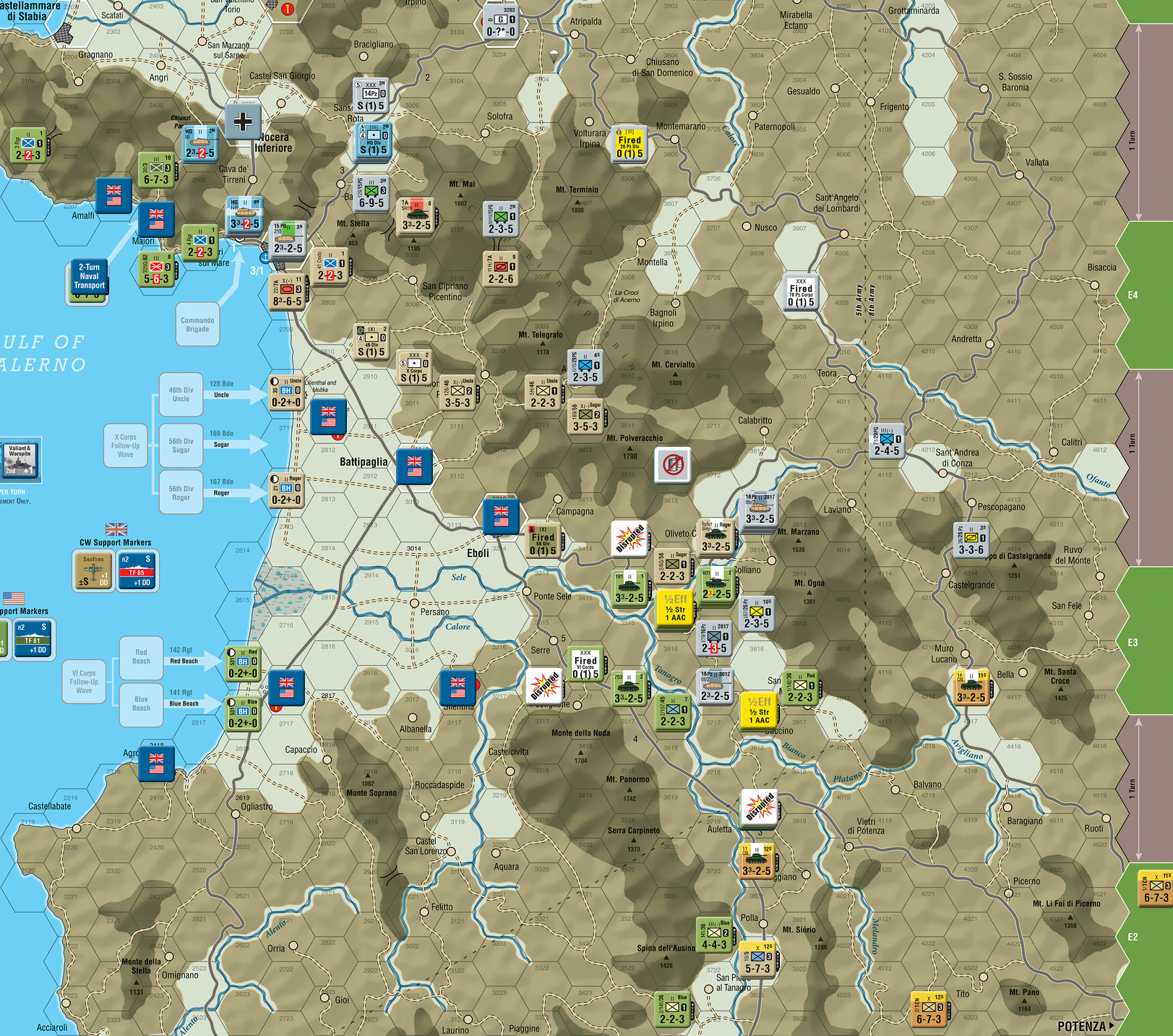
Before combat Sept 20/turn 12.
As the weather started closing in, the Luftwaffe finally showed up, and I kept my operations to one combat to chase off a battalion with losses (I had a second lower-odds combat in mind if the Luftwaffe showed up for this one) near Mt Ogna.
The withdrawal of the 16th Panzer Division thinned already overstretched German lines as the weather turned cloudy. I had sent Rangers up the pass south of Castellammare di Stabia, and Mark knocked them out with a 2:1 A1/D1, but he pulled out of Vietri sul Mare. I was increasingly preoccupied by logjams. The British 56th Division had been starting to cross ridgelines of Mt Polveracchio to get around the gap the Germans were still holding in the center. They now pulled out of the latter to invest the various passes north of there more heavily, relieving garrisons of the 46th Division which would concentrate with the 7th Armored on Salerno and the road to Avellino. The American 3rd Division was just finishing landing in the north where it would continue putting pressure on Nocera Inferiore, and the just arriving 34th Division ended up largely landing at the British beaches and heading through the same area as the 56th.
The second attempt on Salerno got a D1, with -/1H determined defense to thin the defenders, but generated no other progress. The 3rd Division drove closer to Nocera by forcing Germans over the Chiuzi Pass (delay result on determined defense), while the attempt to force the gap in the middle merely disrupted the defenders.
The 23rd was stormy, and I was still largely out of artillery supplies, so the day was largely spent maneuvering as Mark prepared to abandon the 8th Army sector.
The weather cleared up the next day, and indeed, the 8th Army sector was abandoned, giving me the VP for Ariano Irpino (the Canadians had captured the 4111 crossroads last turn). The last unit isolated in 3716 finally surrendered, leaving the routes to the front open, and I started racing units through the abandoned area to flank the German defenders in the American front by getting over the Ofanto. The British 56th Division broke through near Montella, heading north of the Apennines, while the defenders held out against another assault, but were reduced to a single step. The Americans had attacks at both ends of the front, but didn’t gain any ground with a pair of disrupt results.
This forced a reshuffling of the defense, as the odds were, with four units, someone in Nocera Inferiore would not recover from disruption if they stayed put (and be vulnerable to full retreat if I got that again). Once again, I found some places to go that I didn’t think about except as part of something else, and I got a 3:1 on the Nebelwerfer battery (DR2…). The Americans also got over the ridge line west of the Chiunzi Pass, while the British advanced up the road from Salerno to Sanservino Rota, and finally cleared Salerno itself with a DRX result. Meanwhile they also approached Avellino from the east after finishing off the battalion holding up the 56th Division.
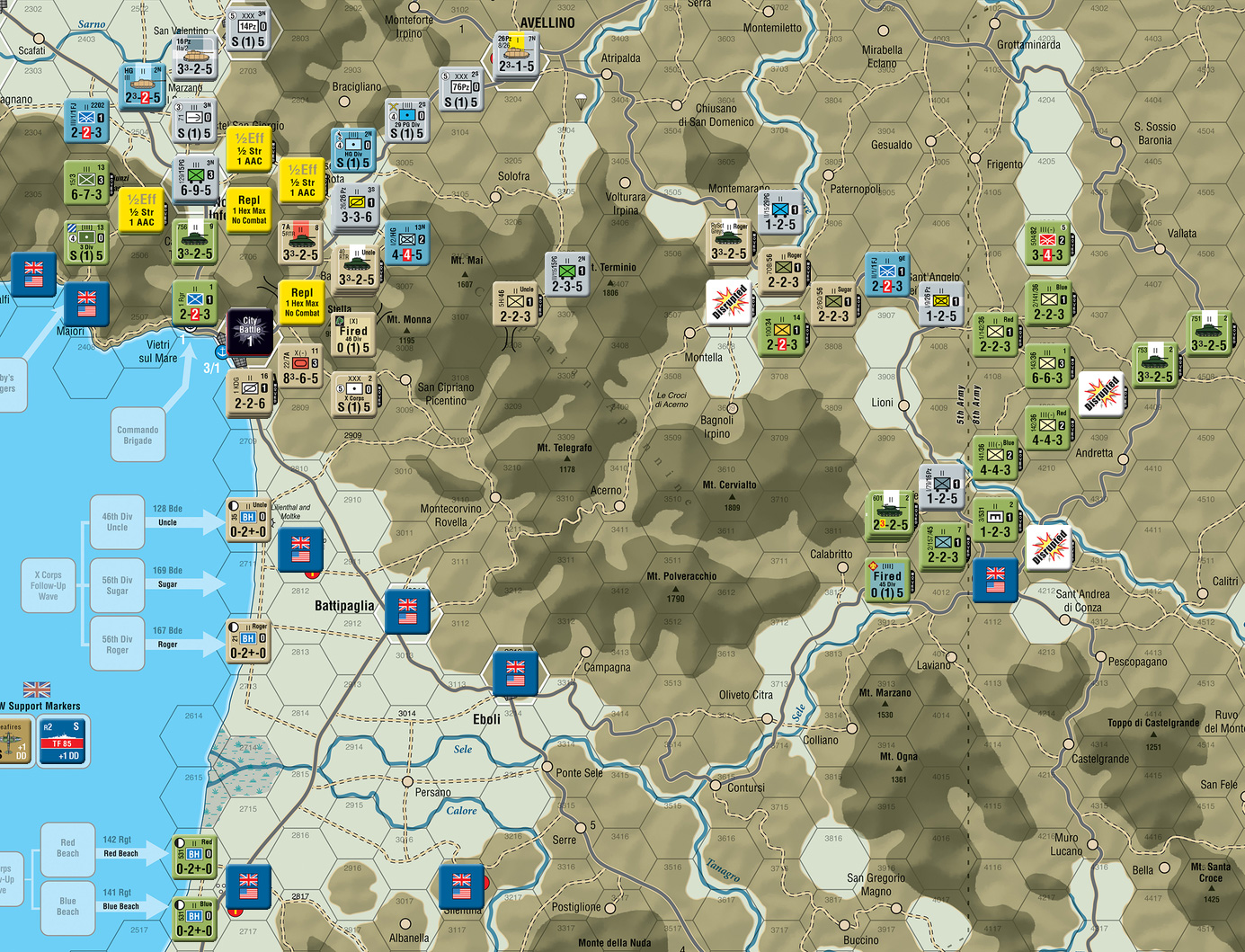
Before combat Sept 25/turn 17.
The weather stayed on clear “B” for the 26th, giving me the bonus supply point on the first turn Salerno was clear (frankly, I’d think the port would be in pretty bad shape after all that). At this point, the German defense was breaking down into purely local concerns of protecting remaining victory point locations, including the northern off-map boxes. The British had poor luck, disrupting a stack in front of Avelino, and suffering A1 against the 76th Panzer Corps artillery. The Americans exchanged steps with the 129/15PG (the big scary 6-9-5) in their drive towards Sarno, while also finally taking Nocera Inferiore.
The Luftwaffe showed up again for the 27th, while Mark counterattacked to knock out a remnant unit, and release his motorized regiment from being cut off. I was able to slip a few units into the N1 box (the road north from Monteforte Irpino was clear), and claim the 5VPs there. An attempt on Sarno failed (A1 on a 2:1 after the Luftwaffe intervened). But main American force was joined by the lead elements of the 34th Division, who knocked out one of the defenders of the central north edge.
Afterword
After that, there was no way for Mark to keep me from exiting anything I desired to the N2 box next turn, and claim 4 VPs. That would send me to 22 VPs, and autovictory on that turn was only 21. As it was, if I’d actually taken Sarno on the 27th, that would have put me exactly at 19 VPs needed for an autovictory then.
The initial attempt to save me a lot of pain at Nocera Inferiore, caused even more pain. It spread me out on that flank, and helped Mark make a successful drive to Salerno. VP-wise, I was 1 to 2 points under par almost the entire game thanks to not having Salerno.
However, I do think after that Mark really needed to shift a couple units from there to the center region. He was actually doing well in the center for a bit, got really unlucky with his attempt on my artillery (any other result would have knocked one of them out), and then over-extended when he tried to cut off the successful American drive. Worse, was throwing good units after bad, though that wasn’t obvious until we saw what my moves and both of our combats would look like. But the Americans had the units in the area to keep chains of hexes open, and the Germans didn’t.
The British were feeling like they had the short end of the stick the entire game up to that point. Successfully taking Eboli (left somewhat open by the rest of the drama) helped insure there wasn’t enough room to maneuver around.
While it was the turning point, it didn’t feel like one on my side of the table for quite a while. I knew the Germans were comparatively short on units, but the approaches to Salerno were still strongly held, and I was still bruised from being kicked around on the plains.
A corollary to not having enough in the center is that the Germans remained quite thin in the south, and I never had to deal with the tough campaign to clear rivers that I’d had against Jason. Since I was prepared for that, the south went pretty well, even when everything else was in trouble.
I also think Mark could have managed the pocket that formed west of Mt Ogna better, but not by much. I was advancing into contact everywhere I could to make pulling out more difficult. But mountain hexsides are a bit more permeable than you want to think, and I think he could have gotten a couple more units out that way.
At any rate, this is my first ‘long-form’ ZOC-bond game, and it certainly held up well!

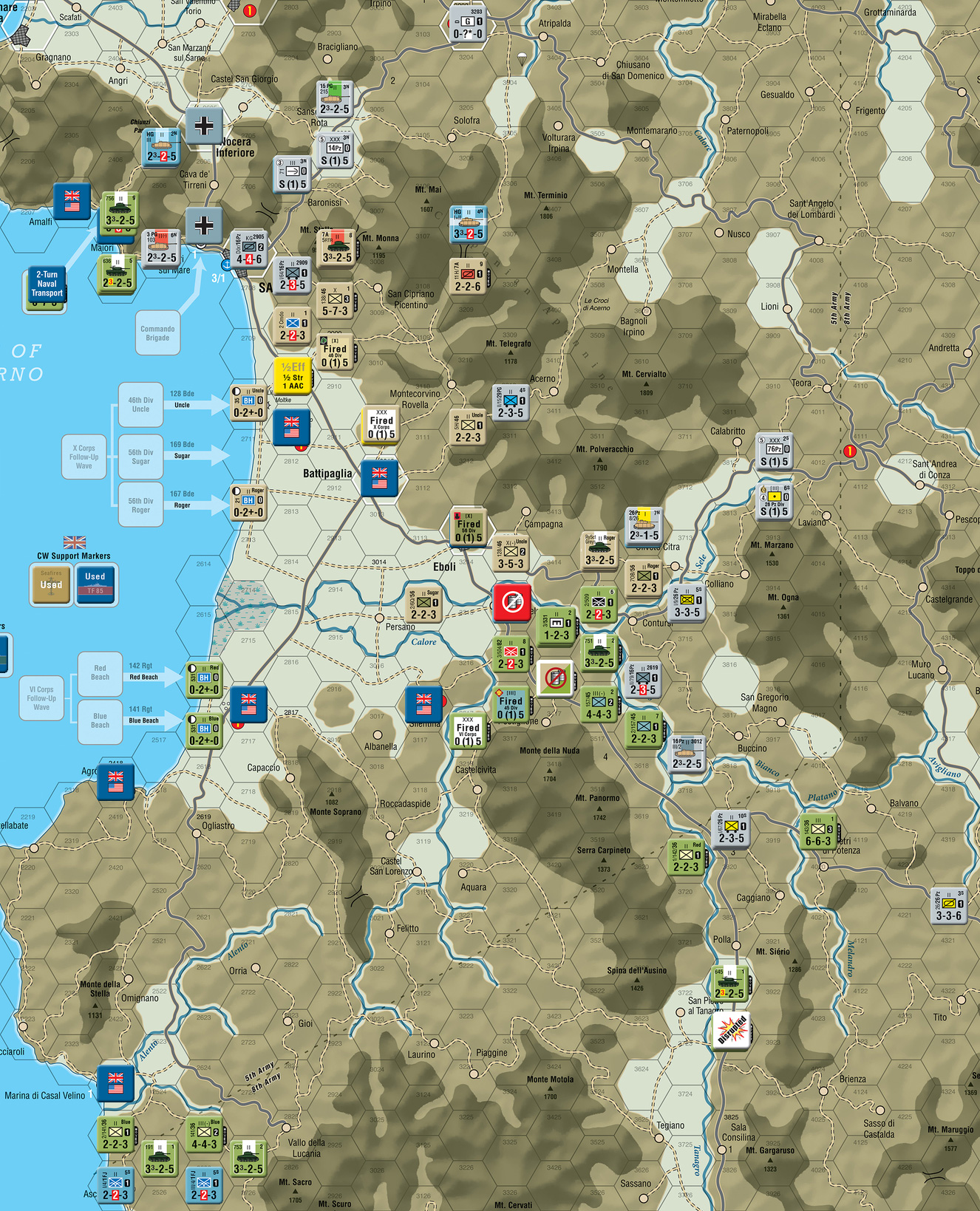
Discussion ¬